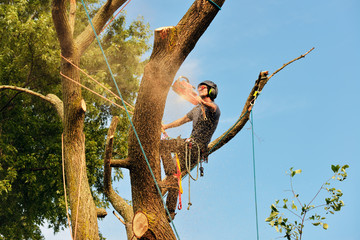Tree removal is cutting down and removing a tree from a specific location. Tree removal may be necessary for various reasons, such as if the tree is dead or diseased, poses a safety risk, or obstructs construction or other projects. The tree removal contractor may also need to remove the stump and roots, clean up debris, and dispose of the tree in an environmentally responsible manner. Hiring a reputable tree removal contractor with the experience and knowledge to safely and efficiently remove trees while minimizing the risk of property damage or injury is important. In some areas, permits or approvals may be required before a tree can be removed, and a professional Tree Service Irvine CA can help navigate these requirements.

Trees provide homeowners with many benefits, from shade and beauty to help improve property value. But sometimes, they need to be removed for safety or health reasons. Removing trees can be dangerous, so it’s always best to hire a professional tree service to take care of the job. But if you’re interested in doing it yourself, you should know a few things first.
The tree removal process can be dangerous if you don’t take the proper precautions. To prevent injuries from cuts, splinters and falling branches, it’s important to wear proper work gloves and safety goggles or glasses when working with any equipment or tools used in the process.
If workers are climbing to dismantle the tree, they should use a harness that has lines attached to it and a hard hat. They should also keep their distance from the tree to avoid being hit by falling debris.
A good rule of thumb is to stay two tree lengths away from the tree when it’s being felled. This is especially true if the tree is on a slope where logs could roll or slide. It’s also a good idea to look around for any fences or buildings that might be near the site, as well as power lines.
If you have a tree that you want to remove, it is important to prepare for the process. This includes making sure that the yard is clear of anything that can interfere with the job, such as vehicles and personal items.
It is also a good idea to inform neighbors of the tree removal project so that they can plan their activities accordingly. This will help avoid conflicts and keep everyone safe.
When preparing for the removal, it is vital to remove any dead branches or leaves that can interfere with the process. This will allow for the proper preparation of the site and allow the workers to get the job done properly.
It is also a good idea to prune the tree before the actual removal takes place. This will prevent any new growth from compromising the tree’s structural integrity and causing damage.
When performing tree removals, it is important to make sure the work is done correctly. While it may seem like a straightforward process, tree removal requires specialized equipment that can be dangerous if not handled properly.
A professional tree service will have all the tools and equipment needed to complete the job. They will also have safety equipment to prevent workers from getting hurt while removing the trees.
For safety purposes, the service will remove a tree in pieces rather than felling it. This involves climbing the tree or using a bucket truck to reach the upper limbs, and then attaching large limbs to a crane before cutting them to lower them to the ground.
Reputable tree services will have a license and insurance cover to protect you from liability in the event of an accident. They should also have certifications from the International Society of Arboriculture (ISA) that show they follow best practices in their work.
Many people are wondering if their homeowners insurance covers tree removal. Depending on the specific policy, insurance companies can pay between $500 and $1,000 per tree, with some offering greater limits for a homeowner who has a lot of mature trees surrounding their home.
For most, the answer is no. This is because homeowners insurance typically only covers sudden, accidental perils.
Generally, if you have an unhealthy tree that has been left to fall because of neglect, it will not be covered by your insurance. The same is true if the tree falls because of an event such as a flood, earthquake or landslide.
Regardless, your homeowners insurance should cover the cost of removing the tree. In some cases, your insurer may also reimburse you for tree removal costs if the tree blocked access to your property.